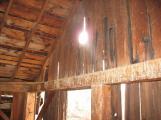27
Interior view on second floor of southern wall12 March 2008
Mill Creek, Kelowna, Okanagan Valley, British Columbia
 Credits:
Credits:Samantha Poling
28
Interior view of second floor north east corner12 March 2008
Mill Creek, Kelowna, Okanagan Valley, British Columbia
 Credits:
Credits:Samantha Poling
29
Interior view of second floor rear wall timbers of the main grist mill building12 March 2008
Mill Creek, Kelowna, Okanagan Valley, British Columbia
 Credits:
Credits:Samantha Poling
30
A close up view of peg in second floor sill plate12 March 2008
Mill Creek, Kelowna, Okanagan Valley, British Columbia
 Credits:
Credits:Samantha Poling
31
Page 4"The millstones were located in the basement of the leanto section of the building. These millstones were actually a complete Stone Mill which was portable and was easily set up in a remote district, as any type of power could be used, including water, wind, animal, or steam. Brent's stones were made out of a freshwater quartz and was quarried in the Marne Valley in northern France, near the town of Chalons. This type of stone later became world famous because of the quality of flour that it produced.
In the case of Brent's millstones, the lower stone revolved and the upper stone was stationary. This type of mill was known as an under-runner mill. The stones were quite small, having a working face of only fifteen inches in diameter. Top speed for these stones would be approximately five hundred revolutions per minute and the power required would be about four horse power (Fleming 1972: 81)."
32
View of leanto ceiling from second floor of main mill building12 March 2008
Mill Creek, Kelowna, Okanagan Valley, British Columbia
 Credits:
Credits:Samantha Poling
33
Interior view of timbers12 March 2008
Mill Creek, Kelowna, Okanagan Valley, British Columbia
 Credits:
Credits:Samantha Poling
34
Interior view of the leanto from the second floor of the mill building12 March 2008
Mill Creek, Kelowna, Okanagan Valley, British Columbia
 Credits:
Credits:Samantha Poling
35
Interior view of the leanto ceiling12 March 2008
Mill Creek, Kelowna, Okanagan Valley, British Columbia
 Credits:
Credits:Samantha Poling
36
Leanto section of the grist mill building2003
Mill Creek, Kelowna, Okanagan Valley, British Columbia
 Credits:
Credits:Lorainne McLarty
37
Millstones from Frederick Brent's grist mill27 March 2008
Kelowna, British Columbia, Canada
 Credits:
Credits:Kelowna Public Archives
Central Okanagan Heritage Society
Samantha Poling
38
Millstones from Frederick Brent's grist mill27 March 2008
Kelowna, British Columbia, Canada
 Credits:
Credits:Kelowna Public Archives
Central Okanagan Heritage Society
Samantha Poling
39
Millstones from Frederick Brent's grist mill27 March 2008
Kelowna, British Columbia, Canada
 Credits:
Credits:Kelowna Public Archives
Central Okanagan Heritage Society
Samantha Poling
40
Page 5"[Water from Mill Creek] ran several hundred feet away from the building and was a few feet lower. Brent solved this problem by building a series of flumes to bring water power from the creek. It was a large job, accomplished in a series of steps.
The first thing that Brent did was to build a small stone weir across the creek that ran in the northeast section of his property. Once the dam was completed, he dug a ditch, four feet wide and one to two feet deep. This brought down to within three hundred feet of the house, at which point he divided it in two, diverting one branch south to irrigate the fields and the other branch towards the mill. On this branch he built a flume. The flume ran to the top of an overshot waterwheel, where the water filled the hand-made, trough shaped cups. The flume was about three feet wide and twelve inches deep and was supported by small round poles. As one cup filled and sank, the next one was raised. In this way, the five or six foot wide wheel turned and power was supplied to the mill (Reverend E. Fleming, personal communication, May 1979)."